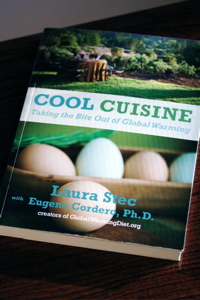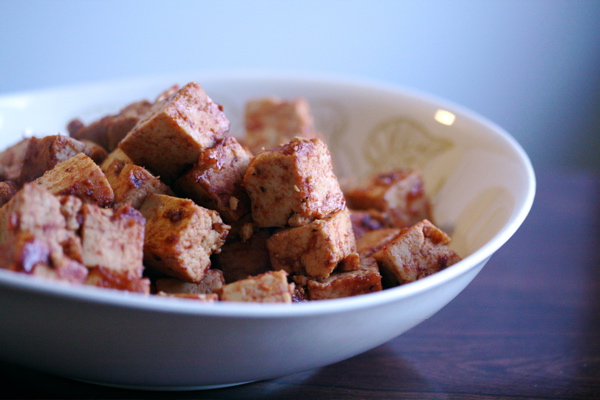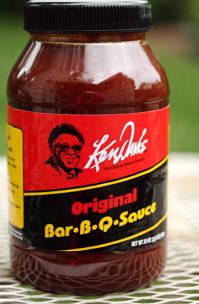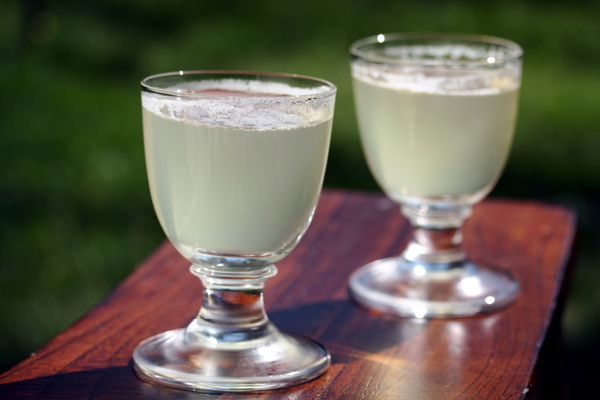
Last week, we gave Heavy Table’s readers a close look at Kate Heyhoe’s recently released Cooking Green: Reducing Your Carbon Footprint in the Kitchen and promised a similar peek at Cool Cuisine: Taking the Bite Out of Global Warming, by Laura Stec, with Eugene Cordero, Ph.D. (Gibbs Smith, $24.99, 244 pages, paperback with flaps). Stec, a personal chef, trained at the Culinary Institute of America, the School of Natural Cookery (which, according to its website, “explains cooking without measuring or using recipes”), and the Vega [macrobiotic] Study Center. Cordero, an associate professor of meteorology at San Jose State University in California, researches the processes responsible for long-term climate change. Stec provides the culinary know-how; Cordero, the science.
While Heyhoe’s Cooking Green was densely packed with specific practical advice about how to prepare meals — from shopping to cooking to clean-up — using less fuel and water, Stec and Cordero’s Cool Cuisine is a meandering exploration. It features vivid color photos and charts illustrating the interrelation between global climate change and our food system.
Each chapter ends with a section, “Book ‘n’ Cook Club Ideas” that recommends print and video resources for further research, as well as recipes inspired by ideas raised in the chapter.
“Changing your diet will not solve global warming all by itself, but it does represent an important piece of the solution and a fun way for you to get involved,” write the authors. “Knowledge of where your food comes from and how to cook it easily will enhance your culinary life and set you up to be part of the solution.”
The book launches with background on global warming: how our diet impacts climate change, and how the climate crisis impacts our food supply. To paint their gloomy picture, the authors cite statistics such as: “It takes more than ten times the fossil fuels to produce a calorie of beef protein than a calorie of grain protein,” and “Processed food makes up three-quarters of global food sales by price (not by quantity) and typically requires more energy to make than what we get back when we eat it.”
The authors touch on food and packaging waste, as well as the effects of mono-cropping, deforestation, and our “overdependence on oil-based fertilizers and industrial agriculture [which] produces nitrous oxide as a by-product, a greenhouse gas with a global warming potential per molecule that is more than three hundred times that of carbon dioxide.”

To keep their readers from spiraling into despair, the authors employ chirpy language (“Talk about a greasy spoon — we emit similar amounts of carbon dioxide eating as we do by driving”) and colorful, but only tangentially relevant personal stories, such as how snorkeling around Malaysia helped Stec “think more deeply about soil — this moist yet friable, mysterious, alive substance to which we literally owe our very survival.” The effect is both endearing and distracting.
Perhaps distraction is what enables you to plow on. By the time the “solutions” section of the book begins, you’re more than ready to embrace eating local, seasonal and organic, or, at least, embrace reading about it. The authors present the “full food cycle,” production, distribution, and execution (cooking and waste disposal) and explain how the three separate components need to “feed into and support each other in order to be sustainable.” They delve into a discussion of food miles, “the number of miles a food product has traveled to reach your plate,” and why, although “the connection between food miles and [global] emissions makes sense, the relationship is actually more complex.” They stress the importance of considering both the method of transportation (air transportation being the least efficient method) and of production (farming intensity and the use of fertilizers) in addition to food miles.
Once you’re convinced that it’s all impossibly complicated and ready to commit to a lifetime of consuming only the twigs and leaves you can collect in your own backyard, the authors trot out “seven innovative recipes for success,” which are profiles of individuals and organizations that are taking bold approaches to solving the global climate crisis. Some of the ideas seem fanciful, such as Dave Culp‘s KiteShip, which installs kites on cargo ships to help harness wind power and reduce their fuel consumption. Others seem astonishingly simple, obvious even, at least in hindsight. Dr. Preston Maring, an obstetrician / gynecologist and hospital administrator convinced hospital dietitians for his employer, Kaiser Permanente, which operates a chain of hospitals in the Western US, to embark on a six-month study to determine how much produce they consume and where it comes from. Kaiser Permanente now strives to buy produce from local farms and in season.

In the book’s final section, “culinary how-to,” the authors strive to teach techniques that readers can employ at home. The major strategies, to each of which the authors devote a chapter, are: “Eat More Vegetables”; “Great Grains” that you should “eat in place of meat”; and using “Small-Farmed Beef, Cheese, Eggs, and Honey.”
While Heyhoe’s Cooking Green includes a section at the back with 50 recipes, Cool Cuisine‘s recipes are scattered throughout the book. This, and the fact that some of the recipes don’t even appear in the index, makes the book frustrating to use as a cookbook. Perhaps they don’t intend for you to cook from it much. “The trick is to get a basic understanding of techniques that work for you without following a recipe,” write the authors. “Then you only need to refer to your cookbooks for new ideas and special occasions.” Several recipes have been included to illustrate a point. For example, “Ruth Leserman’s [Candy-Coated] Caramel Brie” reminds the author (presumably Stec), of the “massive amounts of fertilizer sprayed over the surface of the soil” because of its crisp, hardened, and crackly topping.
I tried three recipes. Two dishes, “BBQ’ed Tofu with Lime” (find the recipe at page 89 here) and “Local Honey Sparkler” (find the recipe here) were successful. I’d make these dishes again. The third dish, “Orange Creamsicle”, for which the authors direct you to stir fresh orange or tangerine juice into organic soy or soy-rice milk, separated into an unappetizing, curdled failure of a beverage. Already a “local” and “in season” scofflaw for having purchased oranges, I promptly violated one of the book’s climate-saving suggestions “Reduce food waste — eat what you buy” and dumped the chunky mess down the drain.

I tried the BBQ’d Tofu with Lime twice. The first time –100% user error– I misunderstood the direction to “slice the tofu into squares” and, instead, cubed it. The cubes were a nuisance to grill, so I finished them in a grill-wok, which worked fine. The tofu squares, on my second attempt, were far easier to handle. They achieved thick grill marks, which were appealing both visually and texturally.
The most difficult part of the recipe was purchasing a “jar of local or regional barbecue sauce” in which to marinate the tofu. Neither Mississippi Market Natural Foods Co-op nor Whole Foods Market had a jar of local barbecue sauce on their shelves on the day I stopped in, though, both Byerly’s on Suburban Ave. in St. Paul, MN and Cub Foods on University Ave. in St. Paul did. At Byerly’s, I picked up a jar of Ken Davis Original Bar-B-Que Sauce, ($4.79) produced by a company out of St. Louis Park, MN, that is operated by Mr. Davis’ widow, Barbara. The check-out clerk said, “I love Ken Davis sauce! For years, I made my barbecue sauce from scratch. But now, I just use Ken’s. It’s much easier. Nice balance between tangy and sweet. My grown kids, even my son the foodie, can’t even tell the difference, as long as I hide the jar.” Dragon Star Oriental Foods in St. Paul, MN occasionally carries blocks of fresh tofu, produced by Asian Classic Catering out of Minneapolis, in their produce section.
While I enjoyed the honey sparkler, I found it unattractively foamy, which would require an explanation if you were to serve it to guests. Also, I was puzzled as to why this recipe, which calls for for a 32-ounce bottle of sparkling water, appears in a chapter in which the authors enumerate the evils of bottled water and encourage their readers to look into home-delivery seltzer as a delicious and healthy option to commercial sparkling water.
In fact, I tried the honey sparkler recipe twice: once with bottled sparkling water as suggested by the recipe and a second time with water I’d carbonated myself using a home carbonation system and tap water. We preferred the sparkler made with the home-carbonated tap water to the one made with bottled water. My husband said, “It tastes fresher.” Interestingly, the authors make this exact point in the chapter. According to a tap water versus bottled water taste test that was held between March and September 2007 with 30 tasters in three cities in the US and Canada, “every tester in every location preferred the tap water to the bottled water, agreeing on one specific difference: The tap water tasted fresher than the bottled water.” Going ultra-local, I made my sparklers with my father-in-law’s and godfather’s blue-ribbon basswood honey, but you can find local honey at Minneapolis and St. Paul farmers’ markets and food co-ops.

If you’re looking for a book, simultaneously sobering and cheerful, that will step you through the high-level science of global climate change then connect the dots all the way to the food on your dinner plate, Cool Cuisine would be a helpful book, indeed. This book is particularly well-suited for use by a book or cooking club. While you might find a few recipe gems, it’s not the primary strength of the book, particularly if you are really trying to eat “local” and seasonal in the upper Midwest. If, on the other hand, you already accept global warming as reality and are just looking for a dizzying blast of suggestions for concrete actions to take, Kate Heyhoe’s Cooking Green is a better choice.

Will have to try the honey sparkler. At this point I am imagining sweet bubbles.
I appreciate the perspective on the two books. And thanks for the cool stats on bottled water and the link to the home carbonation system!
“Crops under stress as temperatures fall”
http://www.telegraph.co.uk/comment/columnists/christopherbooker/5525933/Crops-under-stress-as-temperatures-fall.html